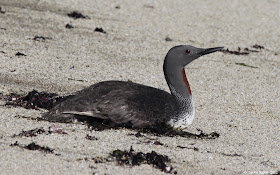Smallest of the loons, the Red-throated Loon (Gavia stellata)
On 30 July 2012, this individual was sitting on the beach, but then pushed along the sand into the water and swam away.
Red-throated Loons tend to hold their bills pointed slightly upward. In breeding plumage, look for the uniform gray head (and sides of the neck). The Birds of North America account states that this color is variable and may be described as "bluish, ash, pearl, glossy dark, dove."
There is a striking pattern of black and white stripes running from the crown down the hindneck (see below). Note that the back lacks the strong white patches common to other species of loons in breeding plumage.
The foreneck has a beautiful rust-red patch (see next photo). [In Europe, Red-throated Loons are sometimes called Red-throated Divers.]
Red-throated Loons are common winter residents in the waters surrounding Bodega Head (including Bodega Harbor). Their spring migration occurs primarily in April-May and fall migration generally begins in September. (They breed from Alaska to southern British Columbia.) Although less common from June-August, "almost annually a few birds summer over at Bodega Harbor and other coastal sites" (Birds of Sonoma County by Bolander and Parmeter).
P.S. Do you know how many species of loons there are in the world? And how many of those have been spotted at or near Bodega Head? (SPOILER ALERT: Answer is in next sentence.)
P.P.S. All five species of loons in the world have been documented at Bodega Head (Arctic, Common, Pacific, Red-throated, Yellow-billed).
ADDENDUM (8 August 2012): In response to the comment/question asking about whether I have a picture of the loon making its way down the beach. I didn't get a picture at that time, but I have one of the loon just as it entered the surf zone (see below).






















































